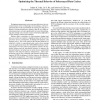Free Online Productivity Tools
i2Speak
i2Symbol
i2OCR
iTex2Img
iWeb2Print
iWeb2Shot
i2Type
iPdf2Split
iPdf2Merge
i2Bopomofo
i2Arabic
i2Style
i2Image
i2PDF
iLatex2Rtf
Sci2ools
ICCD
2005
IEEE
2005
IEEE
Optimizing the Thermal Behavior of Subarrayed Data Caches
Designing temperature-aware microarchitectures for microprocessors at new technologies is becoming a critical requirement due to the exponentially increasing on-chip power density. Extremely high power density, thus the very high onchip temperature, not only significantly increases the packaging and cooling costs, but also creates tremendous difficulties in chip leakage control and reliability. Being a major contributor to chip transistor budget and die area, caches account for a significant share of the overall processor power consumption, including both dynamic and leakage power. This work analyzes the thermal behavior of subarrays within a conventional data cache when running a set of applications from the SPEC2000 benchmark suite, and proposes two new subarraying schemes, namely, the separated scheme and the interleaved scheme, to improve the thermal behavior of subarrays in terms of more predictable behavior and reduced subarray temperatures. These optimizations can be also co...
| Added | 16 Mar 2010 |
| Updated | 16 Mar 2010 |
| Type | Conference |
| Year | 2005 |
| Where | ICCD |
| Authors | Johnsy K. John, Jie S. Hu, Sotirios G. Ziavras |
Comments (0)

